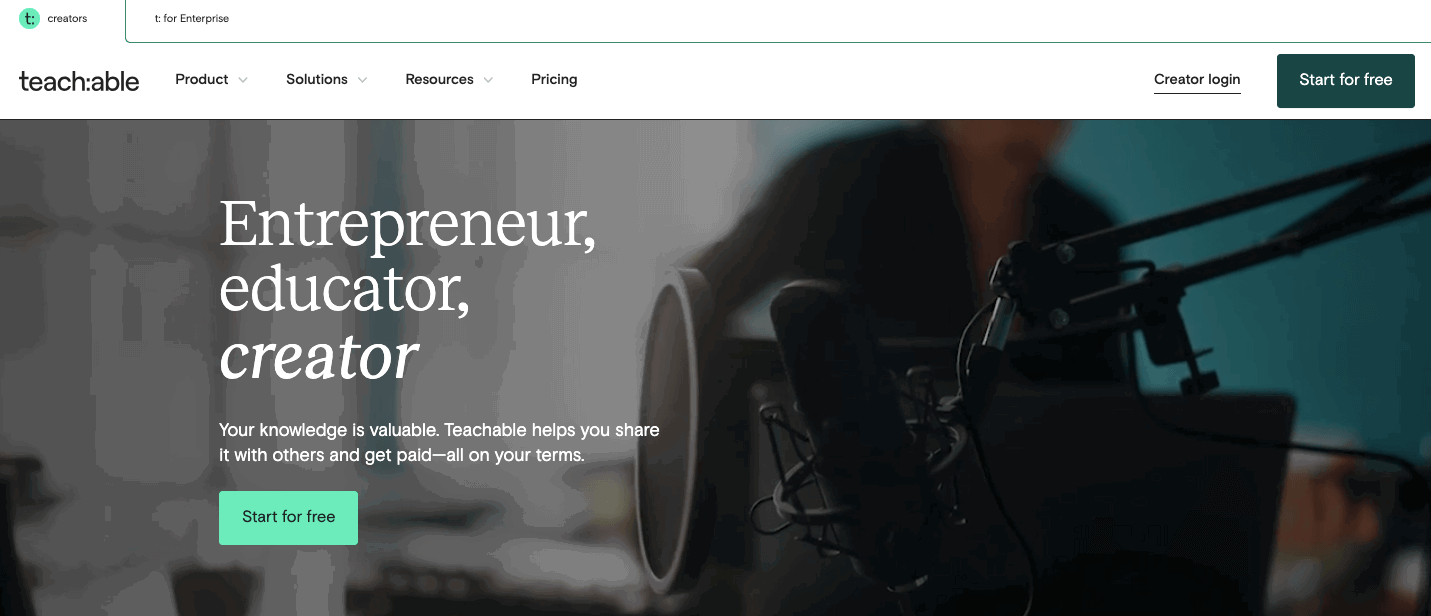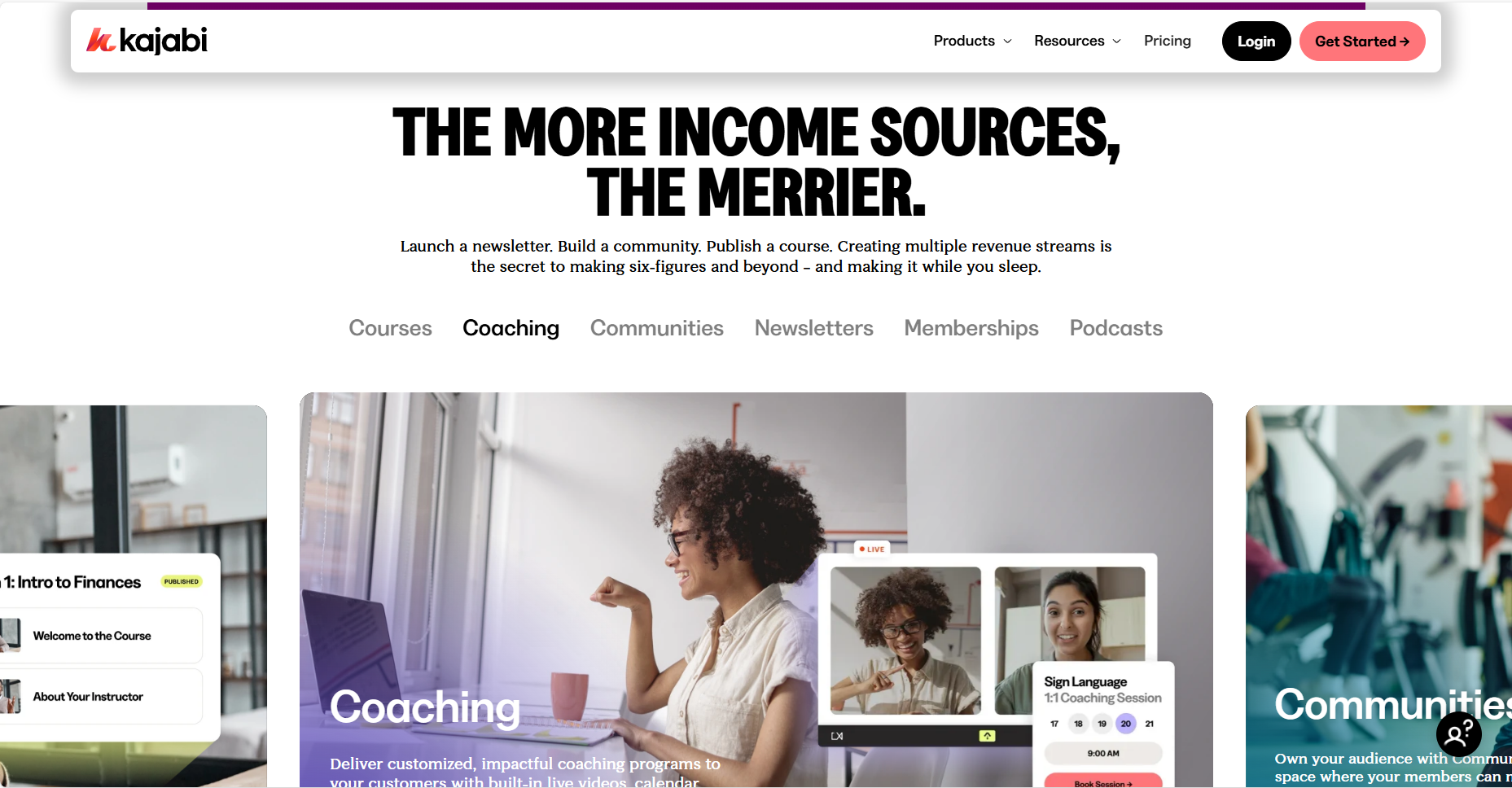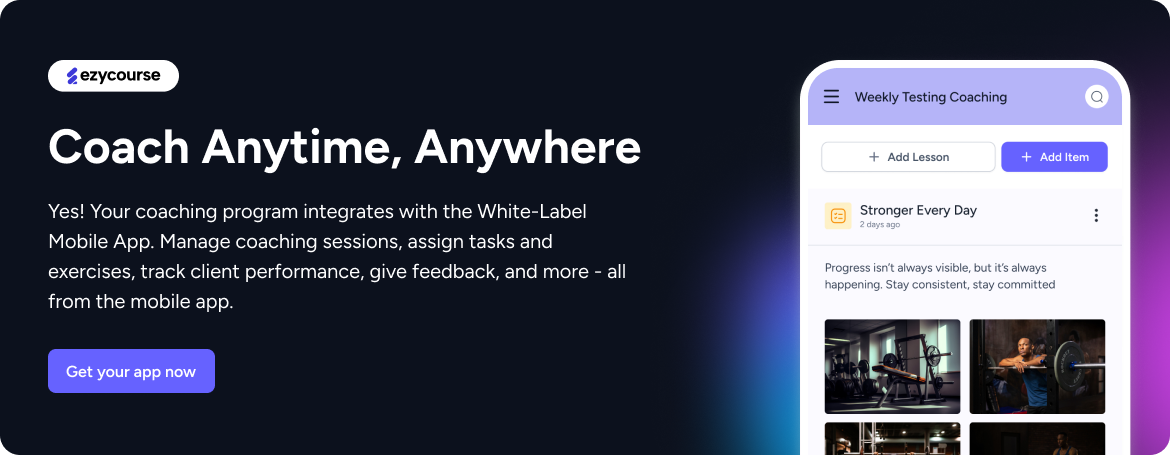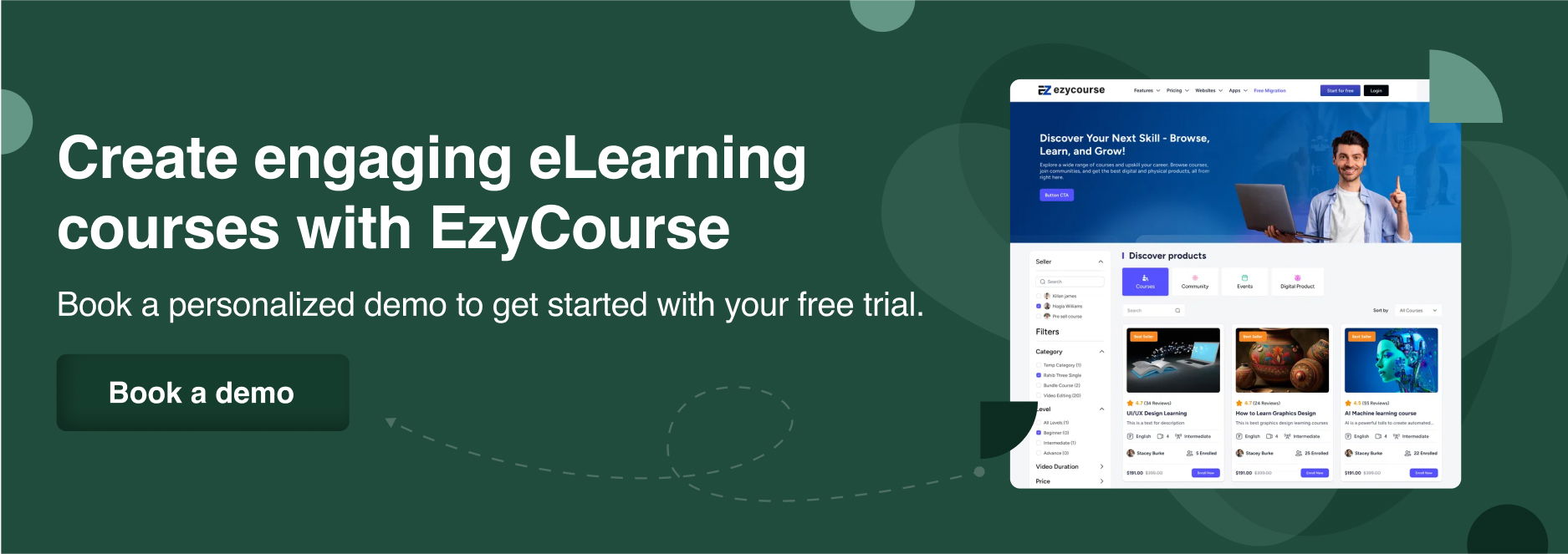It’s no wonder that online learning is growing faster than ever.
In the last year, 2024, the global Massive Open Online Course (MOOC) market was valued at $13.2 billion. Furthermore, by 2034, the market is anticipated to grow to a size of $212.7 billion.
This impressive growth means there’s never been a better time to start teaching your own course online.
But here comes the big question: how to teach a course online? Where do you start?
Honestly speaking, it is easier than you think! First, you need to decide what you want to teach online. Then, plan your lessons and make videos or notes. Next, you will need to choose an online course platform to share your courses. Finally, market your courses, find students. Once you get course enrollments, talk with your students and ask how you can make it better.
In this guide, we will break down the entire process comprehensively. Just read on!
Why Is It the Best Time to Teach a Course Online?
Before moving ahead to the essential tips on how to teach a course online, it’s important to understand why now is the perfect moment to start, right? Actually, online education is just booming.
Students and companies are embracing online learning for its effectiveness and flexibility. It allows you global reach and passive income with long-term impact.
➤ The online learning market is projected to grow to $370 billion by 2026. The market rate is growing at a CAGR of 8.56%.
➤ 70 % of students say online instruction is better than traditional classroom learning
➤ 42 % of US organizations report increased revenue after adopting e-learning
➤ Nearly 49 % of students participate in some kind of online learning
➤ The number of online learners is expected to reach 1.1 billion by 2029.
➤ User penetration in the online education market will be at 15.9% in 2025.
10 Essential Tips to Teach a Course Online
So, are you ready to teach a course online? Actually, teaching a course online requires careful planning and the right approach.
Don’t worry! These essential tips will guide you step-by-step. It will help you teach online classes confidently and effectively in the virtual classroom.
1: Set Clear Learning Goals for Your Students
As for the first step to start teaching courses online, you need to define your course objective. You know, well-defined course objectives are the foundation for any successful online course.
It offers you the direction for your content. So, you can ensure your course perfectly aligns with the needs of your students and sets clear expectations.
So, first, identify what your learners want to learn and understand. Your course objective should be SMART.
S = Specific
M = Measurable
A = Achievable
R = Relevant, and
T = Time-bound
For example, let’s say your course goal is to teach graphic design. Instead of simply saying this, you can say, “By the end of this course, learners will be able to design a professional logo using Adobe Illustrator.” It will be a more strategic course objective.
Your course objective will guide every aspect of course development. Moreover, it also helps the students quickly understand whether your course aligns with their goals.
That indicates clearly that you should invest your time in creating a clear objective. It will result in an enhanced learning experience and will enhance your course credibility.

2: Structure Your Lessons for Effective Teaching

After you clearly define your course objective, you should move ahead to planning your course content. You can ensure that your material flows logically and covers the essential topics.
Firstly, outline your course modules or lessons you will want to include. Keep in mind that each of your modules should contain a specific component of your objective.
Then, you should gradually advance to the next one. That means you should begin with foundational knowledge and then move toward more advanced concepts.

Secondly, you should break your content into small sections. It is essential to avoid overwhelming your learners.
For instance, if you have a 30-minute topic, you can divide it into three 10-minute sections.
As you move ahead with your course content planning, always keep your students in mind. You should consider
What is their current skill level?
What format will be easy for them?
What should you use? Videos, slides, live sessions, or text-based content?
Lastly, you should also include learning outcomes for each section in your course content planning. Thus, your students will better understand your overall course objective.
3: Choose Your Online Course Delivery Method

In simple words, the course delivery method means how you want to present and distribute your course content. That’s the great thing to create an online course online: you have options, and you can choose.
There are three main delivery methods you can choose from. Each of them has its own benefits and drawbacks. Let’s have an idea about them below.
I) Self-paced (Asynchronous)
Self-paced online courses allow students to learn through the content at their own convenience.
In this model, you will create all your course content in advance. Such as recorded videos, downloadable resources, quizzes, and exercises. You will publish them for students to access anytime.
This course delivery method offers flexibility for both you and your students. As for the learner, they can learn on their schedule. Moreover, you are not required to deliver content live.
If your course content is standardized, you may consider the self-paced online course delivery method.
II) Cohort-Based (Synchronous Learning)
In cohort-based courses, you will give live instruction and deliver to a group of students.
These courses include structured schedules and group engagement. Instructors often use platforms like Zoom or Google Meet to host live sessions and workshops. You can also include assignments, projects, and discussions to enhance collaboration.
Cohort-based online courses will be ideal for you if you are focusing on deep skill-building or mentorship.
Moreover, if you are the one who prefers live engagement over pre-recorded content, you may want to choose this method over the others.
III) Hybrid Courses (Blended Delivery)
This online course delivery method is the best of both worlds.
Hybrid courses combine elements of both self-paced and cohort-based learning. For example, you might provide pre-recorded modules for students to review on their own.
Plus, you can also offer live Q&A sessions, workshops, or discussion groups to support learning.
Hybrid or blended delivery will be the best choice if
You are seeking flexibility without sacrificing interaction.
Your courses balance foundational content with changing components
Your audiences need structured content, but also don’t want frequent live sessions
Here’s a quick comparison of the advantages and disadvantages of each online course delivery method. It will help you find out which model will be best for your goals and teaching style.
A sneak-peak of the course delivery methods:

4: Prepare Your Teaching Tools & Equipment

Now that your course content is ready and the course delivery method is planned out, it is time to prep your gear.
Actually, high-quality online courses do not depend only on great content. How you present the content to the audience also matters a lot.
So, what do you need to get started with online teaching? Probably less than you think! Here is a list of essential equipment you will need to get started.
I) Camera
If your course includes video instruction, a good camera is a must. You don’t need to invest much in cameras. Most modern webcams or smartphones are more than capable of capturing clear, high-quality video.
Moreover, natural lighting can enhance your visuals significantly. So, you should try filming during daylight hours with your face toward a window for a balanced look.
II) Microphone
Audio quality often makes a stronger impression than video. Sometimes, it doesn’t affect much if your video quality is not good. But if the sound quality is poor, it can instantly break the students’ focus.
Here, a good set of headphones with a mic can work. That’s because they put the mic closer to your mouth and enhance the sound quality.
You can also consider a USB condenser or lapel mic for better clarity and noise reduction.
II) Tripod or Mount
You’ll want a tripod or mount to keep your camera still during recording. It will help you maintain a high-quality video without shaking much.
IV) Quiet Environment
A quiet environment is equally important to other gears. You should choose a quiet room with minimal background noise. It will enhance your audio quality and make editing much easier.
In addition to hardware, using the right software tools is crucial for creating, delivering your online course effectively.
The following tools can help enhance your course quality and the engagement of your students.
All in all, you can start with what you have and upgrade as you go. Your online course gear doesn’t have to be something fancy or expensive.
What matters the most is how clearly you deliver your message and how well your tools support that experience.
5: Choose the Right Platform to Teach and Manage Your Courses
It is one of the most crucial and most strategic decisions you'll make when teaching online.
A good platform doesn't just store your videos. Instead, it gives you the tools to build an engaging learning experience and grow your brand.
There are more than a number of options available for online course platforms. However, your course goals and technical requirements should guide your decision in choosing the best platform for your online course.
What to Look for in an Online Course Platform

While looking for an online teaching platform, you should consider the following factors:
Ease of Use
An online course platform must be easy to use for both you and your students. You should look for a platform that has an easy-to-use interface and has minimal setup hassle.
Content Management Features
An online course requires a platform that lets you easily upload and organize your course materials. For instance, quizzes, videos, PDFs, and documents.
Plus, if you are looking for enterprise learning management systems for organization training, then don’t forget to check some additional features like advanced user roles, SCORM compliance, detailed analytics, single sign-on (SSO), API integrations, bulk user enrollment, and dedicated account support.
Student Engagement Tools
Next, you have to look for features that help you interact with your students. Like discussion forums and live chats. These tools enhance motivation and improve learning outcomes.
Monetization Options
You should choose a platform that offers flexible payment methods. It will let you monetize your course the way you want.
Analytics & Progress Tracking
Good platforms provide detailed insights into student progress and course performance. It helps you understand what works and where you can improve.
Customer Support and Scalability
Finally, choose a platform that has responsive customer support. Moreover, the platform should have the ability to grow with you as your course attracts more students.
Top 3 Online Course Platforms in 2025
Choosing the right online course platform is essential for a successful online course. However, as already mentioned, there are more than a number of platforms online.
The most difficult part? It is to find out which one fits your needs best. Speaking of which, here are the top 3 platforms to make your decision process easier.
I) EzyCourse

If you're new to online teaching and looking for a platform that is simple and beginner-friendly, EzyCourse is an excellent choice.
It is an all-in-one course platform designed to help creators launch and grow their online courses.
Cherry on the cake? You won’t even need any technical skills or third-party tools to get started with EzyCourse.
EzyCourse comes fully equipped out of the box. You can have all the options that you need to build and grow your online course business.
For example, a drag-and-drop course builder, built-in student communities, live sessions, payment integrations, and detailed analytics. Interestingly, this platform offers free white-label Android & iOS mobile apps included with the Pro plan.
So, if you want an all-in-one solution without being tech-savvy, EzyCourse will be ideal for you.
Key Features:
Course creation and management
Facebook-like community
Memberships
Native email marketing
Live online classes and webinars
Events and appointment scheduling
Pricing:
Basic Plan: $45/month on the annual plan.
Pro Plan: $139/month on the annual plan.
Unlimited Plan: $199/month on the annual plan.
Elite Plan: $299/month on the annual plan.

II) Teachable

Teachable is one of the most well-known platforms for online course creation. It is especially popular among individual educators and small business owners.
It offers a user-friendly interface that makes it easy to upload content and start your course. It focuses on simplicity and quick setup. It’s great for solo educators who want to launch fast.
However, it lacks built-in community tools. You’ll need external platforms for interaction and engagement. So, ultimately, it may add complexity over time. Plus, Teachable suddenly increased their pricing recently. Also, the platform has high transaction fees in the Starter plan.
Related read: Top 15 Best Teachable Alternatives in 2025
Now, let us have a quick comparison between EzyCourse vs Teachable and choose the one that suits your online course the best.

III) Kajabi

Kajabi is an all-in-one platform built for advanced users.
The platform is especially beneficial for consultants and marketers who want more than just course hosting. Say about marketing, customization, monetization, and community spaces, all are top-notch.
However, Kajabi has quite a steep learning curve. Moreover, it comes with a higher price. So, the platform may not be suitable for beginners or solo creators.
Also read: 20 Kajabi Alternatives in 2025
Now, let us have a quick comparison between EzyCourse vs Kajabi and choose the one that suits your online course the best.

Now, let us have a quick comparison between all the three teaching platforms and choose the one that suits you best.
Platform | Ease of Use | Coaching | Community | Monetization Streams | Customization | Pricing | Best For |
EzyCourse | Very intuitive | Advanced | Yes | 20+ revenue streams | High | Most affordable | Complete all-in-one solution |
Teachable | Simple to use | Basic | Limited | 5+ revenue streams | Moderate | Moderate (recent price hike) | For basic online courses |
Kajabi | Complex | Advanced | Yes | 10+ revenue streams | High | Expensive | Businesses & coaches |

6: Deliver Your Lessons with Clarity & Create a Great Learning Experience

This is the step where all your strategic planning will pay off. Organize your content into a clear structure. You should focus on creating a mix of content types. For instance,
Videos for explanations
PDFs or slides for notes
Quizzes to test understanding.

Don’t get stressed to make everything perfect from the first day. You should first just focus on clarity and the value of your content.
In the main content, break down complex ideas into simple and small parts. You should use everyday language and speak directly to your audience. These make your ideas more practical and memorable.
A quick look into how to create a great learning experience for your students:

Visual aids can significantly enhance engagement. You should use slides, images, infographics, screen recordings, or even short animations to explain key points.
Next, always end with a summary to review what was covered. It helps the understanding of your students. They can see the big picture.
Then, include a quiz or hands-on task to check how well your students have understood. It helps the students to memorize things for a long time.
Lastly, keep your video lessons short and focused. It will be best if they are under 10 minutes. You know, small-sized content is easier to understand. Plus, it encourages learners to complete modules at their own pace.

7: Keep Your Students Motivated and Engaged
After creating the course, one of the biggest challenges that most of the creators face is engaging their students in their courses.
No matter how well-structured or informative your lessons are, students are far more likely to drop out if they feel disconnected.
The good news? It does not have to be difficult. Here’s how you can keep engagement high and provide meaningful support:
➜ Send your students a friendly message or video. It will help the students to feel at ease.
➜ You should also use discussion boards or group chats. Here, the students can ask questions freely and connect with each other.
➜ You can also consider hosting a live Q&A or feedback sessions. It will assist you in building a personal connection between the students and teachers.
➜ Moreover, you should try to answer the questions of your students instantly. It will show that you are present and determined in their success.
➜ Last but not least, congratulate students when they complete modules or reach important goals. A little encouragement can take them a long way with you.
➜ You should use emails or platform messages to share updates or reminders. You can also send motivational tips to keep them motivated for your course.
Equally, you should encourage interaction among the students themselves. For this, you can implement several ways. For instance, you can create small study groups. Here, learners will work together on lessons or projects.
Moreover, you can also consider hosting weekly live Q&A sessions. It can be another effective strategy to enhance interaction between the students themselves.
Additionally, provides a space where students can share their work. It helps them to reflect on their progress and receive feedback from both friends and you.
8: Improve Your Teaching with Feedback

Once your course is live, teaching doesn't stop there. Great online instructors constantly improve based on feedback and performance.
That is why you should ask your students for feedback at the end of each module or after course completion.
You can use short surveys, polls, or discussion threads. It can help you to gather honest opinions about what worked and what didn’t.
Also, you should look at the analytics of your platform. Are students dropping off after a certain video? Are some quizzes too difficult?
After gathering, use this insight to revise your content. You should update your lessons according to the feedback.
9: Grow Your Audience

Here comes one of the most crucial steps- promoting your course.
Let’s face it. If people are not seeing your course or what you are selling, they are more likely not to buy it. And if they don’t buy it, your course won’t grow. That’s why promoting your course is just as important as building it.
Marketing an online course requires a multifaceted approach. It requires a combination of strategic planning and targeted communication.
Let’s discuss the strategies that you can use right away.
I) Use social proof

When potential students see that others have taken your course and found real value in it, they’re more likely to enroll. Social proof can be of many types.
Written testimonials
Video reviews
Case studies or even
User-generated content
You should share your students’ feedback on your sales page and showcase reviews across your marketing channels.
II) Get on podcasts
You know it is really an effective way to promote your online course to get on other people’s podcasts.
It helps you to position yourself as the go-to in your industry. You should reach out to shows within your niche and offer to share valuable insights.
Podcast listeners generally listen to your half-hour to one-hour. If your podcasts are effective, they will want to know more about your offers.
III) Write guest posts
It is another great way to get known and build an audience for your course. So, you can try out writing guest posts on others’ websites.
It is true that big publications can be powerful for building your brand. However, you should discount niche and smaller publications.
IV) Presell your course
What people often do is that when their course is totally ready, they start selling their course. That’s not the best strategy, though!
Here is the thing:
When you are creating your course, you can’t be totally sure what exactly your students need. But when you presell your course, you can create it based on the feedback.
The ultimate results? You will be much better positioned to create a stand-out course.
That being said, you will need to create something upfront so that your student can get started with it right away.
V) Create a lead magnet
Lead magnet, you can say it is a ‘freebie’ that you will want to offer on your website when someone signs up for your email list.
As far as the experts are concerned, it is one of the best ways to grow your email audience. So, you should create one for your website to promote your online course.
10: Earn Through Great Teaching

As for earning through teaching an online course, we recommend offering more than one purchasing option wherever possible.
That is because when the buyers get the freedom to choose how they want to pay, it will encourage more course sales.
Below are some of the common monetization options for online courses.
➜ One-Time Course Selling: It is ideal for self-paced or short courses.
➜ Subscription: It is great for ongoing programs or new monthly content.
➜ Membership: It offers students access to all your courses and the community.
➜ Freemium: In this type of monetization, you offer some lessons for free to attract more enrollments. Also includes premium plans. Or, you can provide free courses with premium certificates.
➜ Course Bundling: Here, you will offer a package of multiple related courses for better value.
Fortunately, EzyCourse comes with all the pricing options that you can set for your courses. Also, you can earn money through 1:1 private or group coaching using the platform.

Frequently Asked Questions [FAQs]
Do you have any more queries about how to teach a course online? Let’s try to address some of your common concerns through the queries mostly asked by people.
What qualifications do you need to teach online?
Well, you don’t always need formal teaching credentials to teach online and earn money. However, subject expertise, communication skills, and knowledge of digital platforms can help. You may also require a relevant degree or certification for academic or accredited courses.
What is the best teaching style for online teaching?
In general, a flexible, student-centered teaching style works best for online teaching. Your teaching should include clear instruction and interactive elements. Moreover, video, visuals, and discussions keep the learners engaged and enhance their knowledge.
What is the best platform for teaching online?
Actually, which platform will be best for you for online teaching depends on your goals. However, if you want an all-in-one solution for an online teaching experience, you should consider EzyCourse. It offers you course creation, live classes, student communities, and email marketing all in one easy-to-use platform.
How to be the best online teacher?
You should focus on clear communication and student interaction to be the best online teacher. Moreover, you should stay organized, use effective tools, and offer support while teaching. Plus, ensure to continuously improve your teaching content based on feedback and learning trends.
How often should I update my online course materials?
It totally depends on the nature and scope of your content. But generally, it is recommended to update content at least once a year. If possible, it is better to update more frequently for rapidly changing topics.
Final Words
After going through the detailed discussion of the article, we hope you have a better understanding of how to deliver value and keep your students motivated. In short, you should start small and stay consistent. Moreover, you should keep improving as you go.
Go with EzyCourse if you’re looking for an all-in-one platform to build and grow your online course with ease. Go ahead, follow the tips, build your course, and make a long-term impact in the online course world!






